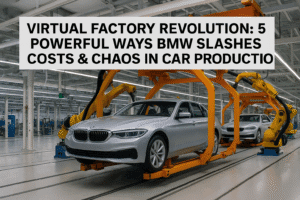Virtual Factory Revolution: 5 Powerful Ways BMW Slashes Costs & Chaos in Car Production
BMW’s Virtual Factory tackles the costly, slow reality of launching new cars by replacing disruptive physical testing with precise digital simulations. Instead of painstakingly guiding real prototypes through production lines over weekends—requiring tasks like draining paint tanks—planners now use integrated 3D scans and vehicle data to run automatic collision checks in a virtual replica of the factory. This slashes validation time from nearly a month to just three days.
Scaling across 30+ global plants, the technology integrates building layouts, robotics, logistics, and even human tasks to optimize processes before physical changes occur. By virtually planning over 40 new models by 2027, BMW anticipates up to 30% lower planning costs and significantly smoother production ramp-ups. The shift signifies a move away from wasteful physical prototypes toward comprehensive digital rehearsal, ensuring stability and efficiency in complex manufacturing.

Virtual Factory Revolution: 5 Powerful Ways BMW Slashes Costs & Chaos in Car Production
Forget futuristic buzzwords – BMW Group’s aggressive scaling of its “Virtual Factory” technology addresses fundamental, costly headaches in automotive manufacturing. This isn’t just about digital twins for the sake of it; it’s a pragmatic response to the immense complexity of launching over 40 new or updated models by 2027. Let’s cut through the jargon to see the tangible human and operational impact.
The Pain Point BMW is Solving (The Old Way):
Imagine this: It’s Friday night. The paint shop line halts. Technicians drain massive, chemical-laden dip coating tanks. Why? Because tomorrow, a physical prototype of a new car body needs to be painstakingly guided through the line by hand over the weekend. Teams watch nervously for any collision – a door handle snagging, a fender bumping equipment. This ritual, repeated across global plants for every model change, consumed weeks of downtime, significant labor costs, and expensive resources. Testing fit and collision risk wasn’t just slow; it was disruptive and wasteful.
Enter the Virtual Factory: Precision Without the Prototype
BMW’s solution replaces physical guesswork with digital certainty. Here’s how it delivers real value:
- Collision Checks: From Weeks to Days (Literally): The core triumph. By integrating precise 3D scans of factories, equipment data, and the new vehicle’s digital model into a simulated production line (powered by NVIDIA Omniverse), BMW can now run exhaustive collision tests virtually. The system simulates the car body moving through every stage, instantly flagging interference risks. What took nearly a month of disruptive physical trials now happens reliably in about three days, digitally. This alone is a game-changer for launch speed and plant stability.
- Slashing the Cost of Complexity: Planning production for 30+ global plants, each with unique layouts and equipment, for 40+ new models is a logistical nightmare. The Virtual Factory acts as a global digital sandbox. Planners can test different scenarios, optimize robot placements, refine logistics flows, and validate processes for any plant configuration before physical changes occur. BMW anticipates up to 30% reduction in production planning costs – savings driven by eliminating physical mock-ups, reducing rework, and speeding time-to-production.
- Beyond Metal: Simulating the Human Touch: It’s not just about robots and car bodies. BMW is integrating human simulations into the Virtual Factory. This allows planners to optimize ergonomics for assembly line workers, test manual task sequences, and identify potential bottlenecks or safety issues before the line is built. This human-centric approach improves both efficiency and worker well-being from day one.
- Future-Proofing Plants: The system’s ability to automatically map entire plant surroundings using 3D scans is crucial for integrating autonomous transport systems and adapting to future layout changes. It creates a living, updatable digital blueprint of the entire facility.
Why This Matters Beyond BMW:
BMW’s Virtual Factory isn’t just about luxury cars; it’s a blueprint for complex manufacturing everywhere. It demonstrates:
- The Death of the Physical Prototype (for Validation): Where repetitive physical testing for fit and function is slow and costly, high-fidelity digital simulation offers a faster, cheaper, and more reliable alternative.
- Data Integration is Key: The power comes from merging previously siloed data – building layouts, machine specs, logistics, product designs – into a single, dynamic simulation environment.
- AI as a Practical Tool: Generative AI and agent-based assistants within the platform aren’t sci-fi; they’re being used to suggest optimizations and automate complex scenario testing, making planners more effective.
- Stability Through Digital Rehearsal: Launching new products in complex factories is inherently risky. Virtual planning drastically reduces the “unknowns,” leading to smoother ramp-ups and fewer costly production hiccups.
The Bottom Line:
BMW’s Virtual Factory transcends being a “cool tech project.” It’s a targeted operational strategy solving the expensive, time-consuming realities of modern manufacturing. By shifting validation and planning into a precise digital realm, BMW gains crucial speed, slashes costs, minimizes launch risks, and ultimately builds better cars more efficiently. It’s a clear signal that the future of manufacturing isn’t just automated; it’s comprehensively simulated. The days of draining tanks for weekend collision tests are, thankfully, becoming a relic of the past.
You must be logged in to post a comment.